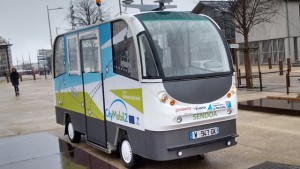There is a long-term future for rural bus services in Britain, but it doesn’t involve humans, or at least human drivers.
A BBC story today (February 4, 2016) dwells on the risk of services in England and Wales being “wiped out” by council budget cuts.
The Campaign for Better Transport said public subsidies to bus routes had been cut by £78m since 2010. A further £27m of support from local government, forced to make cuts under central government deficit reduction targets, was under threat in 2016.
One of the biggest costs in running a bus service is the driver’s wages. (The only buses with conductors these days are on certain routes in London.) The solution must be to run services operated by self-driving (autonomous) buses, which divert to pick up passengers who call them via an app on a smart device.
A fanciful notion for the far future? Certainly not. Look at the video of the Chinese bus, bowling down the freeway between Zhengzhou and Kaifeng, and apparently driving itself. There is a driver, sitting in front of the steering wheel, but his hands are behind his head.
This is not just another zany Facebook video. One of the world’s biggest bus manufacturers, Yutong, is running this research project. The bus drove itself (August 2015) 32.6 km (24 miles), negotiating 26 traffic lights and busy traffic, making lane changes, overtaking, and reaching its destination safely, at a top speed of 68 km/h (42 mph).
China is tired of making trinkets for the West, and wants to do better than assembling high-tech goods developed by Apple in California. It aspires to make products with high value; it has the research facilities and an abundance of highly academically qualified young people to do it. If Yutong can make a bus do this in 2015, don’t underestimate their chances of producing a vehicle that behaves like an every day, convention bus, but without the driver. And before very long.
Around the world there are just too many projects underway developing autonomous vehicles – buses as well as cars – to justify the sceptic’s negativity. The media is right to get excited as each new project is announced. Last week it was Greenwich; this week, the launch of an autonomous bus trial in the Dutch town of Wageningen.
The 4m long WEpod can carry six people at up to 40km/h (25mph), although during the trial it will be limited to 25 km/h (16mph). It will be guided by laser and radar sensors and cameras, with on-board computers controlling steering and the brakes. During the trial a steward will ride in the vehicle in case anything goes wrong.
There is another, EU-backed, project in Greece. Driverless, electric shuttle buses with room for 10 people, driving at a maximum 19 km/h (12 mph), are being tested in the town of Trikala.
I took a trip on one of the shuttles in this project myself, trundling around the harbour area of La Rochelle in western France. The Cybercar negotiated the twists and turns of the road around the dockside and past the University with no difficulty, travelling at between 7 and 10 km/h.
The only person aboard with me was the safety attendant. But I could have done the trip without him. Guided by sensors, and what the on-board computer already knows about the route, the electric bus obeyed a green light to cross at a junction, fitted through a narrow gap between two bollards, and came to a precise halt at bus stops.
In 2015 there was another trial of the vehicles during the 2015 World Exhibition in Milan. More tests are scheduled for Lausanne in Switzerland, the Italian town of Oristano in Sardinia, and Vantaa, Finland.
The people directing this EU project see the first application of these indefatigable little driver-less vehicles on short distance feeder services, taking passengers to existing bus stops and railway stations.
Anyone who lives, say, a mile or two from the nearest railway station, where the car park is often full, and expensive even if there’s space, will see the benefit of this little roving self-driving bus. You could order it via your smart phone for a pickup from your doorstep, to deliver you and perhaps six or 10 others who live close by, in good time for the 7.26. Let it know, and it’ll be at the station to take you home in the evening.
From there, autonomous buses could graduate to running a full rural service, providing transport when people want it, rather than when the operator can afford to run it, now that the cost of employing a driver is taken out of the equation.
It’s easy to be carried away by the seductive appeal of technological solutions, but we’ve reached a point where only radical ideas will get us out of this fix. Public money is simply not going to flow back into supporting rural bus services.

